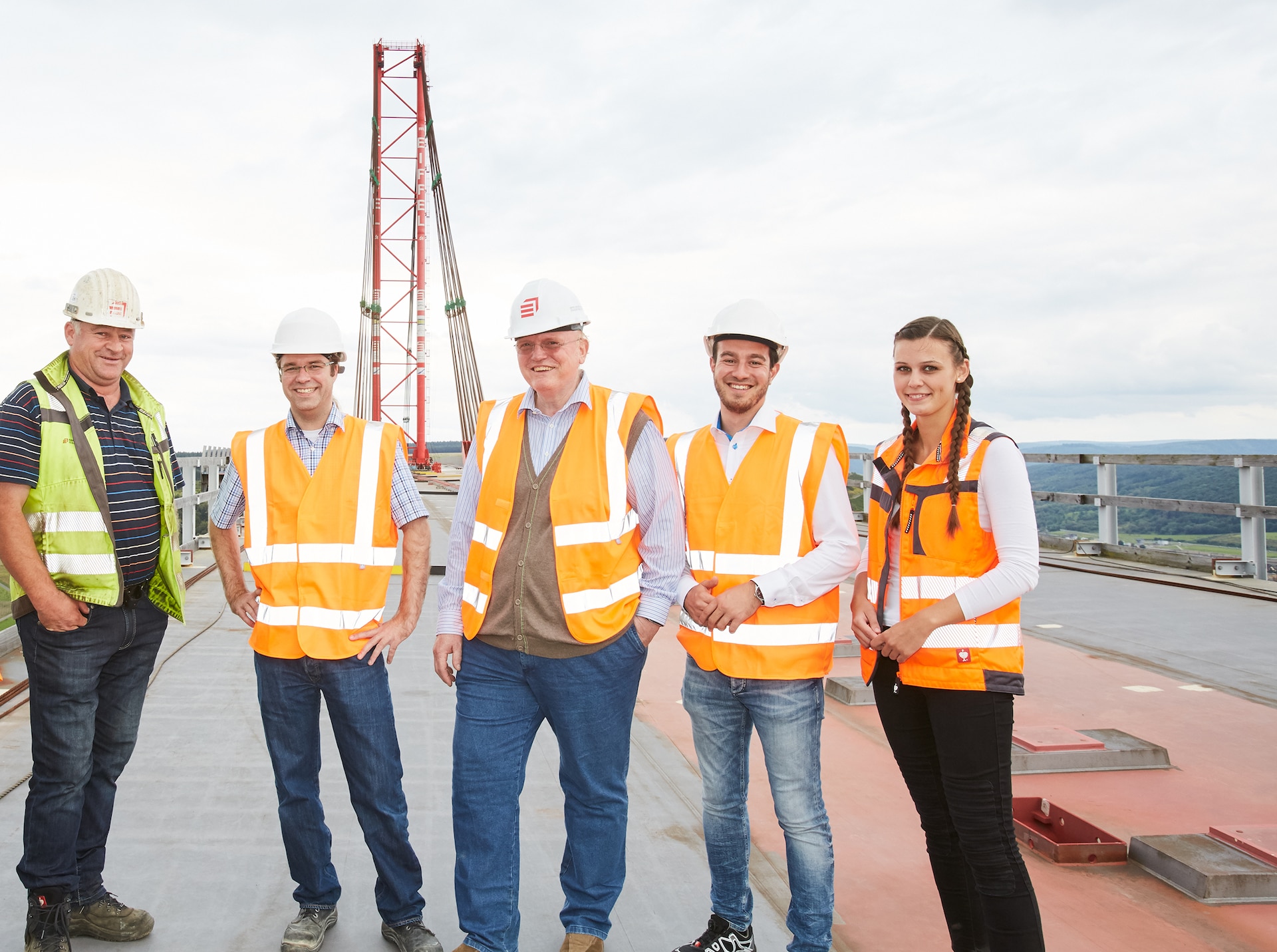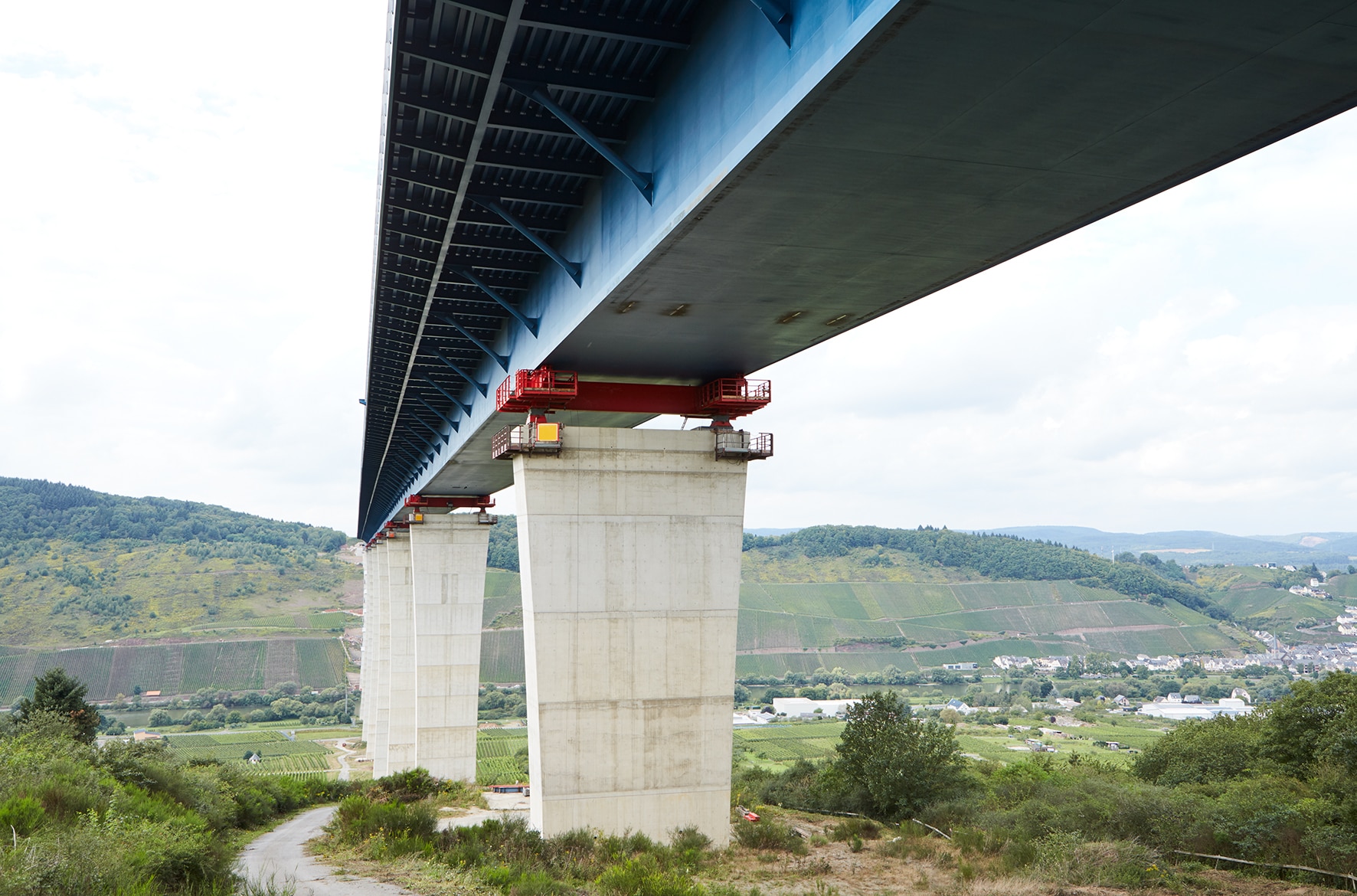At the site of the High Moselle Bridge in Zeltingen-Rachtig in Germany – the largest bridge currently under construction within Europe – a team from Trier University of Applied Sciences are using DML40 and DL1000 long range distance sensors from SICK to monitor deformations in the reinforced concrete pillars, measuring up to 150 meters in height, as the bridge superstructure is moved into place.
Industry 4.0 digital standards even at the construction planning phase
Since 2013, the Civil Engineering department at Trier University of Applied Sciences has been offering support with the construction documentation through a practical on-site project. The team of students headed up by Prof. Henning Lungershausen and Prof. Michél Bender are using DML40 and DL1000 long range distance sensors from SICK to monitor and measure deformations in the reinforced concrete bridge pillars as the steel box girder superstructure is moved into place. The system being used to measure deformations has been recently developed by the Institute for Standard Software-Based Applications in Civil Engineering (ISA) at Trier University of Applied Sciences. Automated deformation measurement is made possible by the combination of time-of-flight measurement, precision engineering, smart control, and real time data processing. The system can locate its measurement target manually or fully automatically, and then take measurements at a maximum of 1 hertz. A minicomputer can be used to record the temperature, date, measured value, and resulting deformation in a database in real time and then visualize this data at any point. Professor Lungershausen believes that this system will be crucial in the future of the conservative construction sector: “Industry 4.0 digital standards are even starting to apply more and more at the planning stage within construction. In the same way that the transition from drawing boards to CAD workstations 30 years ago meant a paradigm shift for many, planners are now facing a jump forward that is likely to be even more significant.”
 A win-win situation for SICK and the university and construction management teams: (from left to right) Michael Arz, Construction Manager at SEH, Prof. Michél Bender, Prof. Henning Lungershausen, Arin Gharibian, Sales Engineer at SICK, and student Verena Franzen.
A win-win situation for SICK and the university and construction management teams: (from left to right) Michael Arz, Construction Manager at SEH, Prof. Michél Bender, Prof. Henning Lungershausen, Arin Gharibian, Sales Engineer at SICK, and student Verena Franzen.
Intelligent measurement technology welcomed with open arms in construction sector
The use of SICK solutions within the High Moselle Bridge project is the ideal way for the company to show off the high levels of reliability, maximum precision, and very large measuring range boasted by the DML40 and DL1000 sensors. The measurement process itself is an extremely challenging and exciting undertaking for all parties involved. After all, thousands of metric tons of steel need to be moved safely over the concrete pillars, some of which are as far as 210 meters apart from one another, centimeter by centimeter.
 The DL1000 long distance sensor is used to target reflectors on each of the pillars when measurements are being taken.
The DL1000 long distance sensor is used to target reflectors on each of the pillars when measurements are being taken.
The DML40 and DL1000 long range distance sensors from SICK proved to be ideal laser measurement units. “Long range distance sensors from SICK are designed for very large ranges. The pulse time-of-flight method allows for measuring ranges of up to 1,500 meters up to a reflector. On that basis, we knew that this was the exact device we were looking for to complete our task,” explains Professor Bender. The resolution of the distance sensors, which fall under IR Laser Class 1, can be adjusted between 0.001 and 100 mm. Depending on the measuring distance, accuracy of up to -10 mm can be achieved for single measurements and 6 mm for repeat measurements.
 The DML40 sensors from SICK are designed for very large ranges.
The DML40 sensors from SICK are designed for very large ranges.
The sensors are installed in a hall at the abutment on the Hunsrück side along with the rest of the equipment forming the measurement system. The university team uses the lasers to target reflectors (foil or glass triple reflectors) that have been attached just underneath the displacement unit on each of the pillars. Before the measurement is actually taken, the reference value has to be defined. In order to determine the zero setting of the measurement system, each of the pillars is recorded over a long period and (ideally) at different temperatures. It does not matter whether the displacement process takes place during a cold winter or warm summer, as the sensors have a rugged metal housing that can withstand temperatures fluctuating between -10 and +55 degrees Celsius.
To start with, the displacement unit is moved into position and contact is made with the hydraulic press. Once all of the units have been set up, the workers wait for Construction Manager Michael Arz to give the signal and then they all start the displacement presses at the same time, thereby moving the superstructure. They keep in contact with the team taking the measurements via radio, as the students monitor the measured values in real time using the measurement system. Construction Manager Arz is notified immediately if any discrepancies are spotted.
With each displacement lasting several days, full concentration is required from every involved in the High Moselle Bridge project and tensions run high. Given that this process is not automated, the work on the construction site depends on the extensive experience and knowledge of all of the workers. Continual monitoring and the use of intelligent measurement technology to keep track of processes are therefore huge benefits that ensure that the construction project runs smoothly.


